Alchon Huns
From Wikipedia, the free encyclopedia
Jump to navigationJump to search
Alchon HunsCapitalCommon languagesReligionGovernmentHistorical era• Established• DisestablishedCurrencyToday part of
| 370–670 | |
|
The bull/ lunar tamga of the Alchon,[1] as visible on Alchon coinage. |
|
|
Alchon
Find spots of epigraphic inscriptions indicating local control by the Alchon Huns in India between 500-530 CE.[2] |
|
| Kapisa | |
| Brahmi and Bactrian (written) | |
| Hinduism, Buddhism | |
| Nomadic empire | |
| Late Antiquity | |
| 370 | |
| 670 | |
| Drachm | |
| Afghanistan Pakistan India |
|
The Alchon Huns, also known as the Alchono, Alxon, Alkhon, Alkhan, Alakhana and Walxon, were a nomadic people who established states in Central Asia and South Asia during the 4th and 6th centuries CE.[1] They were first mentioned as being located in Paropamisus, and later expanded south-east, into the Punjab and central India, as far as Eran and Kausambi. The Alchon invasion of the Indian subcontinent eradicated the Kidarite Huns who had preceded them by about a century, and contributed to the fall of the Gupta Empire, in a sense bringing an end to Classical India.[3][4]
The invasion of India by the Huna peoples follows invasions of the subcontinent in the preceding centuries by the Yavana (Indo-Greeks), the Saka (Indo-Scythians), the Palava (Indo-Parthians), and the Kushana (Yuezhi). The Alchon Empire was the third of four major Huna states established in Central and South Asia. The Alchon were preceded by the Kidarites and the Hephthalites, and succeeded by the Nezak Huns. The names of the Alchon kings are known from their extensive coinage, Buddhist accounts, and a number of commemorative inscriptions throughout the Indian subcontinent.
The Alchons have long been considered as a part or a sub-division of the Hephthalites, or as their eastern branch, but now tend to be considered as a separate entity.[1][5][6]
Contents
- 1Name
- 2History
- 3Religion and ethics
- 4Consequences on India
- 5Sources
- 6Rulers
- 7Coinage
- 8Notes
- 9References
- 10External links
Name
See also: Origin of the Huns
To contemporaneous observers in India, the Alchon were one of the Hūṇa peoples (or Hunas),[7] whose origins are controversial. A seal from Kausambi associated with Toramana, bears the title Hūnarāja ("Huna King").[8] Toramana is also described as a Huna (

Hūṇā) in the Rishtal inscription.[9][10]

The word "Alchono" (αλχοννο) in the Greco-Bactrian cursive script, on a coin of Khingila.[11][12][13]
The Hunas appear to have been the peoples known in contemporaneous Iranian sources as Xwn, Xiyon and similar names, which were later Romanised as Xionites or Chionites. The Hunas are often linked to the Huns that invaded Europe from Central Asia during the same period. Consequently, the word Hun has three slightly different meanings, depending on the context in which it is used: 1) the Huns of Europe; 2) groups associated with the Huna people who invaded northern India; 3) a vague term for Hun-like people. The Alchon have also been labelled "Huns", with essentially the second meaning, as well as elements of the third.[14][15]
The name "Alchon" generally given to them comes from the Bactrian legend of their early coinage, where they simply imitated Sassanian coins to which they added the name "alchono" (αλχονο, also αλχοννο)[16] in Bactrian script (a slight adaptation of the Greek script) and the tamgha symbol of their clan.[17][18][11][19] Several original coins such as those of Khingila also bear the mention "alchono" together with the Tamgha symbol.[11] Philologically, "alchono" (αλχονο) may be a combination of al- for Aryan and -xono for Huns, although this remains hypothetical.[12] Another etymology could be al-, Turkish for scarlet, and -xono for Huns, meaning "Red Huns", red being a symbol of the south among steppe nomads.[20]
History
Invasion of Bactria (370 CE)
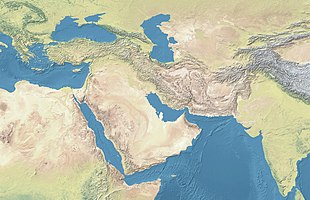

ALKHON
HUNS
The Alkhons are initially recorded in the area of Bactria circa 370 CE, from where they confronted the Sasanian Empire to the west and the Kidarites to the southeast.
Appearance of the Alchon tamgha
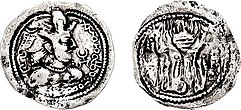

An early Alchon coin based on the design of Sasanian coinage, with bust imitating Sasanian king Shapur II (r.309 to 379 CE), only adding the Alchon Tamgha symbol

and "Alchono" (αλχοννο) in Bactrian script on the obverse. Dated 400-440 CE.[17][21][22]
During the reign of Shapur II, the Sasanian Empire and the Kushano-Sasanians gradually lost the control of Bactria to these invaders from Central Asia, first the Kidarites from around 335 CE, then the Hephthalites and the Alchon Huns from 370 CE, who would follow up with the invasion of India.[23]
Early confrontations between the Sasanian Empire of Shapur II with the nomadic hordes from Central Asia called the "Chionites" were described by Ammianus Marcellinus: he reports that in 356 CE, Shapur II was taking his winter quarters on his eastern borders, "repelling the hostilities of the bordering tribes" of the Chionites and the Euseni ("Euseni" is usually amended to "Cuseni", meaning the Kushans),[24][25] finally making a treaty of alliance with the Chionites and the Gelani, "the most warlike and indefatigable of all tribes", in 358 CE.[26] After concluding this alliance, the Chionites (probably of the Kidarites tribe)[27] under their King Grumbates accompanied Shapur II in the war against the Romans, especially at the Siege of Amida in 359 CE. Victories of the Xionites during their campaigns in the Eastern Caspian lands were also witnesses and described by Ammianus Marcellinus.[28]
The Alchon Huns occupied Bactria circa 370 CE, where they started minting coins in the style of Shapur II but bearing their name "Alchono", and emerged in Kapisa around 380, taking over Kabulistan from the Sassanian Persians, at the same time the Kidarites (Red Huns) still ruled in Ghandara. The Alchon Huns are said to have taken control of Kabul in 388.[7]
The Alchon Huns initially issued anonymous coins based on Sasanian designs.[21] Several types of these coins are known, usually minted in Bactria, using Sasanian coinage designs with busts imitating Sasanian kings Shapur II (r.309 to 379 CE) and Shapur III (r.383 to 388 CE), adding the Alchon Tamgha

and the name "Alchono" (αλχοννο) in Bactrian script (a slight adaptation of the Greek script which had been introduced in the region by the Greco-Bactrians in the 3rd century BCE) on the obverse, and with attendants to a fire altar, a standard Sasanian design, on the reverse.[29][30] It is thought the Alchons took over the Sasanian mints in Kabulistan after 385 CE, reusing dies of Shapur II and Shapur III, to which they added the name "Alchono".[31]
Gandhara (460 CE)
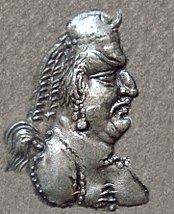
Portrait of King Khingila, founder of the Alchon Huns, on one of his coins, c. 430 – 490 CE.
Around 430 King Khingila, the most notable Alchon ruler, and the first one to be named and represented on his coins with the legend "χιγγιλο" (Kiggilo) in Bactrian, emerged and took control of the routes across the Hindu Kush from the Kidarites.[7][1] He seems to have been a contemporary of the Sassanian ruler Bahram V.[1] As the Alchons took control, diplomatic missions were established in 457 with China.[32]:162 Khingila, under the name Shengil, was called "King of India" in the Shahnameh of Ferdowsi.[6]
Alchon ruler Mehama (r.461-493) was elevated to the position of Governor for Sasanian Emperor Peroz I (r. 459-484), and described himself as "King of the people of Kadag and governor of the famous and prosperous King of Kings Peroz" in a 462-463 letter.[33] He allied with Peroz I in his victory over the Kidarites in 466 CE, and may also have helped him take the throne against his brother Hormizd III.[34] But he was later able to wrestle autonomy or even independence.[34]
Between 460 and 470 CE, the Alchons took over Gandhara and the Punjab which also had remained under the control of the Kidarites, while the Gupta Empire remained further east.[35][15] They apparently undertook the mass destruction of Buddhist monasteries and stupas at Taxila, a high center of learning, which never recovered from the destruction.[36] Virtually all of the Alchon coins found in the area of Taxila were found in the ruins of burned down monasteries, where apparently some of the invaders died alongside local defenders during the wave of destructions.[36] It is thought that the Kanishka stupa, one of the most famous and tallest buildings in antiquity, was destroyed by them during their invasion of the area in the 460s CE.[37]
The rest of the 5th century marks a period of territorial expansion and eponymous kings, several of which appear to have overlapped and ruled jointly.[38][Note 1] The Alchon Huns invaded parts of northwestern India from the second half of the 5th century.[39] According to the Bhitari pillar inscription, the Gupta ruler Skandagupta already confronted and defeated an unnamed Huna ruler circa 456-457 CE.[39]
Sindh

Uncertain Hunnic chieftain. Sindh. 5th century.
Main article: Sasanian coinage of Sindh
From circa 480 CE, there are also suggestion of Hunnic occupation of Sindh, between Multan and the mouth of the Indus river, as the local Sasanian coinage of Sindh starts to incorporate sun symbols or a Hunnic tamgha to the design.[40] These little-known coins are usually described as the result of the invasions of the "Hephthalites".[40] The quality of the coins also becomes very much degraded by that time, and the actual gold content becomes quite low compared to the previous Sasanian-style coinage.[41]
Contributions
The Hūṇas were precisely ruling the area of Malwa, at the doorstep of the Western Deccan, at the time the famous Ajanta caves were made by ruler Harisena of the Vakataka Empire.[42][43] Through their control of vast areas of northwestern India, the Huns may actually have acted as a cultural bridge between the area of Gandhara and the Western Deccan, at the time when the Ajanta or Pitalkhora caves were being decorated with designs of Gandharan inspiration, such as Buddhas dressed in robes with abundant folds.[44]
First Hunnic War: Central India
Kausambi

The monastery of Ghoshitarama in Kausambi was probably destroyed by the Alchon Huns under Toramana.[8]

"Hūna Rāja" Toramana seal impression, Kausambi[45]
In the First Hunnic War (496–515),[2] the Alchon reached their maximum territorial extent, with King Toramana pushing deep into Indian territory, reaching Gujarat and Madhya Pradesh in Central India, and ultimately contributing to the downfall of the Gupta Empire.[32]:162 To the south, the Sanjeli inscriptions indicate that Toramana penetrated at least as far as northern Gujarat, and possibly to the port of Bharukaccha.[46] To the east, far into Central India, the city of Kausambi, where seals with Toramana's name were found, was probably sacked by the Alkhons in 497–500, before they moved to occupy Malwa.[2][47][48]:70[49] In particular, it is thought that the monastery of Ghoshitarama in Kausambi was destroyed by Toramana, as several of his seals were found there, one of them bearing the name Toramana impressed over the official seal of the monastery, and the other bearing the title Hūnarāja ("King of the Huns"), together with debris and arrowheads.[8] Another seal, this time by Mihirakula, is reported from Kausambi.[8] These territories may have been taken from Gupta Emperor Budhagupta.[48]:79 Alternatively, they may have been captured during the rule of his successor Narasimhagupta.[50]
First Battle of Eran (510 CE)
A decisive battle occurred in Malwa, where a local Gupta ruler, probably a governor, named Bhanugupta was in charge. In the Bhanugupta Eran inscription, this local ruler reports that his army participated in a great battle in 510 CE at Eran, where it suffered severe casualties.[50] Bhanugupta was probably vanquished by Toramana at this battle, so that the western Gupta province of Malwa fell into the hands of the Hunas.[50]
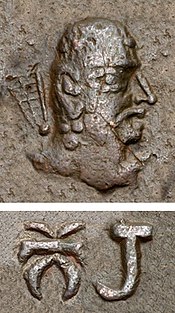
portrait of Toramana and Gupta script initials


Tora, from his bronze coinage. He sacked Kausambi and occupied Malwa.
According to a 6th-century CE Buddhist work, the Manjusri-mula-kalpa, Bhanugupta lost Malwa to the "Shudra" Toramana, who continued his conquest to Magadha, forcing Narasimhagupta Baladitya to make a retreat to Bengal. Toramana "possessed of great prowess and armies" then conquered the city of Tirtha in the Gauda country (modern Bengal).[51][Note 2] Toramana is said to have crowned a new king in Benares, named Prakataditya, who is also presented as a son of Narasimha Gupta.[52][50]

The Eran "Varaha" boar, under the neck of which can be found the Eran boar inscription mentioning the rule of Toramana.[53]













Mahārājadhirāja Shrī Toramāṇa
"Great King of Kings, Lord Toramana"
in the Eran boar inscription of Toramana in the Gupta script.[54]
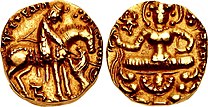
A rare gold coin of Toramana in the style of the Guptas. The obverse legend reads: "The lord of the Earth, Toramana, having conquered the Earth, wins Heaven".[55][56]
Having conquered the territory of Malwa from the Guptas, Toramana was mentioned in a famous inscription in Eran, confirming his rule on the region.[50] The Eran boar inscription of Toramana (in Eran, Malwa, 540 km south of New Delhi, state of Madhya Pradesh) of his first regnal year indicates that eastern Malwa was included in his dominion. The inscription is written under the neck of the boar, in 8 lines of Sanskrit in the Brahmi script. The first line of the inscription, in which Toramana is introduced as Mahararajadhidaja (The Great King of Kings),[48]:79 reads:
"In year one of the reign of the King of Kings Sri-Toramana, who rules the world with splendor and radiance..."
— Eran boar inscription of Toramana.[53]
On his gold coins minted in India in the style of the Gupta Emperors, Toramana presented himself confidently as:
""Avanipati Torama(no) vijitya vasudham divam jayati"
"The lord of the Earth, Toramana, having conquered the Earth, wins Heaven"
— Toramana gold coin legend.[55][56]
The fact that the Alchon Huns issued gold coins, such as the Toramana issue, in addition to their silver and copper coins, suggest that their empire in India was quite rich and powerful.[57]
Defeat (515 CE)
Toramana was finally defeated by local Indian rulers. The local ruler Bhanugupta is sometimes credited with vanquishing Toramana, as his 510 CE inscription in Eran, recording his participation in "a great battle", is vague enough to allow for such an interpretation. The "great battle" in which Bhanagupta participated is not detailed, and it is impossible to know what it was, or which way it ended, and interpretations vary.[58][59][60] Mookerji and others consider, in view of the inscription as well as the Manjusri-mula-kalpa, that Bhanugupta was, on the contrary, vanquished by Toramana at the 510 CE Eran battle, so that the western Gupta province of Malwa fell into the hands of the Hunas at that point,[50][52] so that Toramana could be mentioned in the Eran boar inscription, as the ruler of the region.[50]
Toramana was finally vanquished with certainty by an Indian ruler of the Aulikara dynasty of Malwa, after nearly 20 years in India. According to the Rīsthal stone-slab inscription, discovered in 1983, King Prakashadharma defeated Toramana in 515 CE.[2][46][61] The First Hunnic War thus ended with a Hunnic defeat, and Hunnic troops apparently retreated to the area of Punjab.[2] The Manjusri-mula-kalpa simply states that Toramana died in Benares as he was returning westward from his battles with Narasimhagupta.[50]
Second Hunnic War: to Malwa and retreat
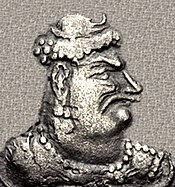
Mihirakula on one of his coins. He was finally defeated in 528 by King Yasodharman.
The Second Hunnic War started in 520, when the Alchon king Mihirakula, son of Toramana, is recorded in his military encampment on the borders of the Jhelum by Chinese monk Song Yun.[2] At the head of the Alchon, Mihirakula is then recorded in Gwalior, Central India as "Lord of the Earth" in the Gwalior inscription of Mihirakula.[2] According to some accounts, Mihirakula invaded India as far as the Gupta capital Pataliputra, which was sacked and left in ruins.[62][48]:64
There was a king called Mo-hi-lo-kiu-lo (Mihirakula), who established his authority in this town (Sagala) and ruled over India. He was of quick talent, and naturally brave. He subdued all the neighbouring provinces without exception.
— Xuanzang "The Record of the Western Regions", 7th century CE[63]
The destructions of Mihirakula are also recorded in the Rajatarangini:[6]
“Mihirakula, a man of violent acts and resembling Kāla (Death) ruled in the land which was overrun by hordes of Mlecchas… the people knew his approach by noticing the vultures, crows, and other [birds], which were flying ahead to feed on those who were being slain within his army’s [reach]”
— The Rajatarangini[6]
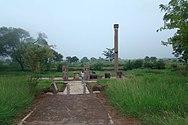
Pillar of Yashodharman near Mandsaur, with the Sondani inscription claiming victory over Mihirakula of the Alchons in 528 CE.
Finally however, Mihirakula was defeated in 528 by an alliance of Indian principalities led by Yasodharman, the Aulikara king of Malwa, in the battle of Sondani in Central India, which resulted in the loss of Alchon possessions in the Punjab and north India by 542. The Sondani inscription in Sondani, near Mandsaur, records the submission by force of the Hunas, and claims that Yasodharman had rescued the earth from rude and cruel kings,[64][Note 3] and that he "had bent the head of Mihirakula".[2] In a part of the Sondani inscription Yasodharman thus praises himself for having defeated king Mihirakula:[53]


)







,[65] (Ja)yatu Mihirakula ("Let there be victory to Mihirakula").[66] Rev: Dotted border around Fire altar flanked by attendants, a design adopted from Sasanian coinage.[67][68][69]
He (Yasodharman) to whose two feet respect was paid, with complimentary presents of the flowers from the lock of hair on the top of (his) head, by even that (famous) king Mihirakula, whose forehead was pained through being bent low down by the strength of (his) arm in (the act of compelling) obeisance
— Sondani pillar inscription[64][70]
The Gupta Empire emperor Narasimhagupta is also credited in helping repulse Mihirakula, after the latter had conquered most of India, according to the reports of Chinese monk Xuanzang.[71][72] In a fanciful account, Xuanzang, who wrote a century later in 630 CE, reported that Mihirakula had conquered all India except for an island where the king of Magadha named Baladitya (who could be Gupta ruler Narasimhagupta Baladitya) took refuge, but that was finally captured by the Indian king. He later spared Mihirakula's life on the intercession of his mother, as she perceived the Hun ruler "as a man of remarkable beauty and vast wisdom".[72] Mihirakula is then said to have returned to Kashmir to retake the throne.[73][32]:168 This ended the Second Hunnic War in c. 534, after an occupation which lasted nearly 15 years.[2]
Retreat to Gandhara and Kashmir (530 CE)

Coinage of Sri Pravarasena, successor of Mihirakula, and supposed founder of Srinagar. Obverse: Standing king with two figured seated below. Name "Pravarasena". Reverse: goddess seated on a lion. Legend "Kidāra". Circa 6th-early 7th century CE
The Alchon Huns resettled in the area of Gandhara and Kashmir in northwestern India under the rule of Sri Pravarasena (c.530-590 CE), thought to be the son of Toramana.[74] His reign probably lasted about 60 years from circa 530 CE.[74][75] According to Kalhana's 12th century text Rajatarangini, Pravarasena established a new capital named Pravarapura (also known as Pravarasena-pura). Based on topographical details, Pravarapura appears to be same as the modern city of Srinagar.[76][74] He also built a temple named "Pravaresha".[74][75]
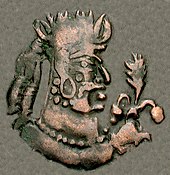
Portrait of Narendraditya Khinkhila, from his coinage.
Pravarasena was probably succeeded by a king named Gokarna, a follower of Shiva, and then by his son king Narendraditya Khinkhila.[75][74] The son of Narendraditya was Yudhishthira, who succeeded him as king, and was the last known king of the Alchon Huns.[74] According to the Rajatarangini, Yudhishthira ruled 40 years until circa 670 CE, but he was dethroned by Pratapaditya, son of the founder of the Karkoṭa Empire, Durlabhvardhana.[77]
Retreat to Kabulistan

Alchon-Nezak "crossover coinage", 580–680. Nezak-style bust on the obverse, and Alchon tamga

within double border on the reverse.[78]
Around the end of the 6th century CE, the Alchons withdrew to Kashmir and, pulling back from Punjab and Gandhara, moved west across the Khyber pass where they resettled in Kabulistan. There, their coinage suggests that they merged with the Nezak – as coins in Nezak style now bear the Alchon tamga mark.[78][53]
During the 7th century, continued military encounters are reported between the Hunas and the northern Indian states which followed the disappearance of the Gupta Empire. For example, Prabhakaravardhana, the Vardhana dynasty king of Thanesar in northern India and father of Harsha, is reported to have been "A lion to the Huna deer, a burning fever to the king of the Indus land".[79]:253
The Alchons in India declined rapidly around the same time that the Hephthalites, a related group to the north, were defeated by an alliance between the Sassanians and the Western Turkic Kaghanate.[80]:187 Eventually, the Nezak-Alchons were replaced by the Turk shahi dynasty.[80]:187
Religion and ethics

The period of Huna rule corresponds to the last stages of Greco-Buddhist art. 7th century, Ghorband District, Afghanistan.
The four Alchon kings Khingila, Toramana, Javukha, and Mehama are mentioned as donors to a Buddhist stupa in the Talagan copper scroll inscription dated to 492 or 493 CE, that is, at a time before the Hunnic wars in India started. This corresponds to a time when the Alchons had recently taken control of Taxila (around 460 CE), at the center of the Buddhist regions of northwestern India.[81]
Persecution of Buddhism
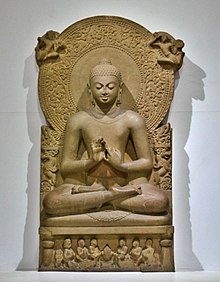
Meditating Buddha from Sarnath, Gupta era, 5th century CE.
Later, however, the attitude of the Alchons towards Buddhism is reported to have been negative. Mihirakula in particular is remembered by Buddhist sources to have been a "terrible persecutor of their religion" in Gandhara in northern Pakistan.[82] During his reign, over one thousand Buddhist monasteries throughout Gandhara are said to have been destroyed.[83] In particular, the writings of Chinese monk Xuanzang from 630 CE explained that Mihirakula ordered the destruction of Buddhism and the expulsion of monks.[32]:162 Indeed, the Buddhist art of Gandhara, in particular Greco-Buddhist art, becomes essentially extinct around that period. When Xuanzang visited northwestern India in c. 630 CE, he reported that Buddhism had drastically declined, and that most of the monasteries were deserted and left in ruins.[84]
Although the Guptas were traditionally a Brahmanical dynasty,[85] around the period of the invasions of the Alchon the Gupta rulers had apparently been favouring Buddhism. According to contemporary writer Paramartha, Mihirakula's supposed nemesis Narasimhagupta Baladitya was brought up under the influence of the Mahayanist philosopher Vasubandhu.[85] He built a sangharama at Nalanda and a 300 ft (91 m) high vihara with a Buddha statue within which, according to Xuanzang, resembled the "great Vihara built under the Bodhi tree". According to the Manjushrimulakalpa (c. 800 CE), king Narasimhsagupta became a Buddhist monk, and left the world through meditation (Dhyana).[85] Xuanzang also noted that Narasimhagupta Baladitya's son Vajra, who also commissioned a sangharama, "possessed a heart firm in faith".[86]:45[87]:330
The 12th century Kashmiri historian Kalhana also painted a dreary picture of Mihirakula's cruelty, as well as his persecution of the Buddhist faith:
Solar symbolism

Solar symbol on the coinage of Toramana.

Khingila with solar symbol.

Alchon king with small male figure wearing solar nimbus.
"In him, the northern region brought forth, as it were, another god of death, bent in rivalry to surpass... Yama (the god of death residing in the southern regions). People knew of his approach by noticing the vultures, crows and other birds flying ahead eager to feed on those who were being slain within his army's reach. The royal Vetala (demon) was day and night surrounded by thousands of murdered human beings, even in his pleasure houses. This terrible enemy of mankind had no pity for children, no compassion for women, no respect for the aged"
— 12th century Kashmiri historian Kalhana[72]
Shivaism and Sun cult
The Alchons are generally described as sun worshipers, a traditional cult of steppe nomads. This stems from the appearance of sun symbols on some of their coins, combined with the probable influence they received from the worship of Surya in India.[88] Mihirakula is also said to have been an ardent worshiper of Shiva,[89][90] although he may have been selectively attracted to the destructive powers of the Indian deity.[72]
Mihirakula is said to have been the founder of the Shankaracharya Temple, a shrine dedicated to Shiva in Srinagar,[91][92] a shrine to Shiva named Mihiresvara in Halada, and a large city called Mihirapura.[92]
Consequences on India
See also: Classical India and Decline of Buddhism in India

Alchon territories of Mihirakula, c. 500 CE (in green).
The Alchon invasions, although only spanning a few decades, had long term effects on India, and in a sense brought an end to the middle kingdoms of India.[72] Soon after the invasions, the Gupta Empire, already weakened by these invasions and the rise of local rulers, ended as well.[79]:221 Following the invasions, northern India was left in disarray, with numerous smaller Indian powers emerging after the crumbling of the Guptas.[93]
The Huna invasions are said to have seriously damaged India's trade with Europe and Central Asia,[72] particularly Indo-Roman trade relations, which the Gupta Empire had greatly benefited from. The Guptas had been exporting numerous luxury products such as silk, leather goods, fur, iron products, ivory, pearl and pepper from centers such as Nasik, Paithan, Pataliputra and Benares. The Huna invasion probably disrupted these trade relations and the tax revenues that came with them.[94] Furthermore, Indian urban culture was left in decline, and Buddhism, gravely weakened by the destruction of monasteries and the killing of monks, started to collapse.[72] Great centers of learning were destroyed, such as the city of Taxila, bringing cultural regression.[72] The art of Mathura suffered greatly from the destructions brought by the Hunas, as did the art of Gandhara in the northwest, and both schools of art were nearly wiped out under the rule of the Huna Mihirakula.[95]
During their rule of 60 years, the Alchons are said to have altered the hierarchy of ruling families and the Indian caste system. For example, the Hunas are often said to have become the precursors of the Rajputs.[72] On the artistic side however, the Alchon Huns may have played a role, just like the Western Satraps centuries before them, in helping spread the art of Gandhara to the western Deccan region.[96]
Coinage legacy (6th-12th century CE)
Main article: Indo-Sasanian coinage
As they invaded northern and central India circa 500 CE, the Alchon Huns issued several types of coinage on the model of the Sasanian Empire, with ruler in profile on the obverse and sacred fire with attendants on the reverse.[97] It is thought that in the process of minting coins in occupied lands, they transmitted Sasanian coin designs to northern and western India.[97] This created a major type of Indian coinage called "Indo-Sasanian coinage", which lasted in degraded form until the 12th century CE as far as the Gangetic region.[97]
Sources
Ancient sources refer to the Alchons and associated groups ambiguously with various names, such as Huna in Indian texts, and Xionites in Greek texts. Xuanzang chronicled some of the later history of the Alchons.[71]
Modern archeology has provided valuable insights into the history of the Alchons. The most significant cataloguing of the Alchon dynasty came in 1967 with Robert Göbl's analysis of the coinage of the "Iranian Huns".[98] This work documented the names of a partial chronology of Alchon kings, beginning with Khingila. In 2012, the Kunsthistorisches Museum completed a reanalysis of previous finds together with a large number of new coins that appeared on the antiquities market during the Second Afghan Civil War, redefining the timeline and narrative of the Alchons and related peoples.[80]
Talagan copper scroll
Main article: Talagan copper scroll
A significant contribution to our understanding of Alchon history came in 2006 when Gudrun Melzer and Lore Sander published their finding of the "Talagan copper scroll", also known as the "Schøyen Copper Scroll", dated to 492 or 493, that mentions the four Alchon kings Khingila, Toramana, Javukha, and Mehama (who was reigning at the time) as donors to a Buddhist reliquary stupa.[99][Note 4][Note 5]
Rulers
Alchon Huns(400–670 CE)
The rulers of the Alchons practiced skull deformation, as evidenced from their coins, a practice shared with the Huns that migrated into Europe. The names of the first Alchon rulers do not survive. Starting from 430 CE, names of Alchon kings survive on coins[98] and religious inscriptions:[99]
- anonymous kings (400 - 430 CE)
- Khingila (c. 430 – 490 CE)
- Javukha/Zabocho (c. mid 5th – early 6th CE)
- Mehama (c. 461 – 493 CE)
- Lakhana Udayaditya (c. 490's CE)
- Aduman
- Toramana (c. 490 – 515 CE)
- Mihirakula (c. 515 – 540 CE)
- Pravarasena (c. 530 – 590 CE)
- Toramana II (c. 530 – 570 CE)
- Gokarna (c. 570 – 590 CE)
- Narana/Narendra (c. 590 – 630 CE)
- Yudhishthira (630-670 CE)
Coinage
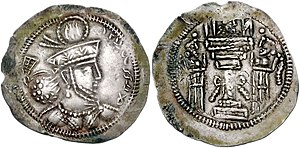
An early Alchon Huns coin based on a Sasanian design, with bust imitating Sasanian king Shapur III. Only the legend "Alchono" appears on the obverse in the Greco-Bactrian script.[17][29][100]
Early Bactrian coinage based on Sasanian designs
The earliest Alchon Hun coins were based on Sasanian designs, often with the simple addition of the Alchon tamgha and a mention of "Alchon" or "Alkhan".[21] Various coins minted in Bactria and based on Sasanian designs are known, often with busts imitating Sasanian kings Shapur II (r.309 to 379 CE) and Shapur III (r.383 to 388 CE), with attendants to a fire altar on the reverse.[29][101] It is thought that the Sasanids lost control of Bactria to the Kidarites during the reign of Shapur II circa 370 CE, followed by the Hephthalites, and subsequently by the Alchon.[23]
Later original coinage
Later Alchon coinage became original and differed from predecessors in that it was devoid of Iranian (Sasanian) symbolism.[7] The rulers are depicted with elongated skulls, apparently a result of artificial cranial deformation.[7]
After their invasion of India the coins of the Alchon were numerous and varied, as they issued copper, silver and gold coins, sometimes roughly following the Gupta pattern. The Alchon empire in India must have been quite significant and rich, with the ability to issue a significant volume of gold coins.[102]
Main coin types

Alchon Tamgha symbol on a coin of Khingila.

Khingila with the word "Alchono" in Bactrian script (αλχονο) and the Tamgha symbol on his coins.[19][104]

Silver drachm of Javukha, mid-late 5th century.

Silver drachm of Mehama legend: “ṣāhi mehama", mid-late 5th century.

Silver drachm of Lakhana, late 5th-early 6th centuries.

Gold dinar of Adomano, Kushano-Sasanian style, mid-late 5th century.

Silver drachm of Mihirakula, early-mid 6th century.
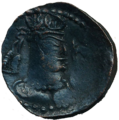
Bronze drachm of Toramana II wearing trident crown, late-phase Gandharan style. mid 6th century.

Silver stater of Toramana II, Kashmir style, mid-late 6th century.

Bronze drachm of Narana-Narenda (possibly Toramana II) wearing trident crown, late 6th century.

Khingila as a young king, without headdress. Artificial cranial deformation clearly visible.

Vishnu Nicolo Seal representing Vishnu with a worshipper (probably Mihirakula), 4th–6th century CE. The inscription in cursive Bactrian reads: "Mihira, Vishnu and Shiva". British Museum.
Notes
Part of a series on theHistory of AfghanistanRelated historical names of the region
Timeline |
Ancient[show] |
Medieval[show] |
Modern[show] |
Afghanistan portal |
- ^ "Here, for the first time, the names of Hepthalite (Alchon) kings are given, some of them otherwise known only from coins. Another important fact is that it dates all these kings in the same time." from Aydogdy Kurbanov (2010). The hephthalites: archaeological and historical analysis. Berlin: Free University of Berlin. p. 120. OCLC 863884689. Retrieved 17 June 2018.
- ^ "After the successful conclusion of the Eran episode, the conquering Hunas ultimately burst out of Eastern Malwa and swooped down upon the very heart of the Gupta empire. The eastern countries were overrun and the city of the Gaudas was occupied. The Manjusrimulakalpa gives a scintillating account of this phase of Toramana’s conquest. It says that after Bhanugupta's defeat and discomfiture, Toramana led the Hunas against Magadha and obliged Baladitya (Narasimha-gupta Baladitya, the reigning Gupta monarch) to retire to Bengal. This great monarch (Toramana), Sudra by caste and possessed of great prowess and armies took hold of that position (bank of the Ganges) and commanded the country round about. That powerful king then invested the town called Tirtha in the Gauda country." in Upendra Thakur (1967). The Hūṇas in India. 58. Varanasi: Chowkhamba Sanskrit Series Office. p. 122. OCLC 551489665.
- ^ "The earth betook itself (for succour), when it was afflicted by kings of the present age, who manifested pride; who were cruel through want of proper training; who,from delusion, transgressed the path of good conduct; (and) who were destitute of virtuous delights " from "Sondhni pillars: where Punjabis met with their Waterloo 1500 years ago". Punjab Monitor. Amritsar: Bhai Nand Lal Foundation. 27 April 2013. Retrieved 8 July 2018.
- ^ "Together with the great sahi Khingila, together with the god-king Toramana, together with the mistress of a great monastery Sasa, together with the great sahi Mehama, together with Sadavikha, together with the great king Javukha, the son of Sadavikha, during the reign of Mehama."from Gudrun Melzer; Lore Sander (2000). Jens Braarvig (ed.). A Copper Scroll Inscription from the Time of the Alchon Huns. Buddhist manuscripts. 3. Oslo: Hermes Pub. pp. 251–278. ISBN 9788280340061.
- ^ For an image of the copper scroll: Coin Cabinet of the Kunsthistorisches Museum Vienna Showcase 8
- ^ For equivalent coin, see CNG Coins
- ^ This coin is in the collection of the British Museum. For equivalent coin, see CNG Coins
References
'박트리아·쿠샨·사산왕조' 카테고리의 다른 글
| <펌>Ancient Iranian religion (0) | 2020.09.12 |
|---|---|
| <펌> Nezak Huns (484-665) (0) | 2020.07.08 |
| <펌> Hephthalites (440-710) (0) | 2020.07.08 |
| <펌> Huna people (0) | 2020.07.08 |
| <펌> Xionites (0) | 2020.07.08 |


